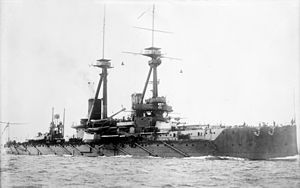 Bellerophon underway in 1909
| |
| History | |
|---|---|
| Name | Bellerophon |
| Namesake | Bellerophon |
| Ordered | 30 October 1906 |
| Builder | HM Dockyard, Portsmouth |
| Laid down | 3 December 1906 |
| Launched | 27 July 1907 |
| Completed | February 1909 |
| Commissioned | 27 February 1909 |
| Fate | Sold for scrap, 8 November 1921 |
| General characteristics (as built) | |
| Class and type | Bellerophon-class dreadnought battleship |
| Displacement | 18,596 long tons (18,894 t) (normal) |
| Length | 526 ft (160.3 m) (o/a) |
| Beam | 82 ft 6 in (25.1 m) |
| Draught | 27 ft (8.2 m) |
| Installed power |
|
| Propulsion | 4 × shafts; 2 × steam turbine sets |
| Speed | 21 knots (39 km/h; 24 mph) |
| Range | 5,720 nmi (10,590 km; 6,580 mi) at 10 knots (19 km/h; 12 mph) |
| Complement | 680–720 |
| Armament |
|
| Armour | |
HMS Bellerophon was the lead ship of her class of three dreadnought battleships built for the Royal Navy in the first decade of the 20th century. She spent her whole career assigned to the Home and Grand Fleets. Aside from participating in the Battle of Jutland in May 1916 and the inconclusive action of 19 August, her service during the First World War generally consisted of routine patrols and training in the North Sea. The ship was deemed obsolete after the war and was used as a training ship before she was placed in reserve. Bellerophon was sold for scrap in 1921 and broken up beginning the following year.